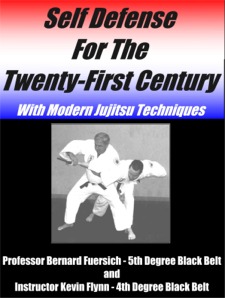|
I would like to take a moment to discuss some stretches
that were once considered safe but now are not. Much of the following
information comes from this url
Link
and is an excellent summary of dangerous stretches still being performed
by martial arts schools.
Note: The following graphics are from the
web since I would not want to demonstrate any of these stretches with my
own body.
The following stretches (many of which are commonly performed) are
considered risky due to the fact that they have a very high risk of
injury for the athlete that performs them. This does not mean that these
stretches should never be performed. However, great care should be used
when attempting any of these stretches. Unless you are an advanced
athlete or are being coached by a qualified instructor (such as a
certified Yoga instructor, physical therapist, or professional trainer),
you can probably do without them (or find alternative stretching
exercises to perform).
- the yoga plough
-
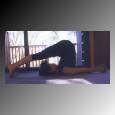 In
this exercise, you lie down on your back and then try to sweep your
legs up and over, trying to touch your knees to your ears. This
position places excessive stress on the lower back, and on the discs
of the spine. Not to mention the fact that it compresses the lungs
and heart, and makes it very difficult to breathe. This particular
exercise also stretches a region that is frequently flexed as a
result of improper posture. This stretch is a prime example of an
exercise that is very easy to do incorrectly. However, with proper
instruction and attention to body position and alignment, this
stretch can be performed successfully with a minimal amount of risk
and can actually improve spinal health and mobility. In
this exercise, you lie down on your back and then try to sweep your
legs up and over, trying to touch your knees to your ears. This
position places excessive stress on the lower back, and on the discs
of the spine. Not to mention the fact that it compresses the lungs
and heart, and makes it very difficult to breathe. This particular
exercise also stretches a region that is frequently flexed as a
result of improper posture. This stretch is a prime example of an
exercise that is very easy to do incorrectly. However, with proper
instruction and attention to body position and alignment, this
stretch can be performed successfully with a minimal amount of risk
and can actually improve spinal health and mobility.
-
-
- the traditional backbend
-
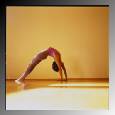 In
this exercise, your back is maximally arched with the soles of your
feet and the palms of your hands both flat on the floor, and your
neck tilted back. This position squeezes (compresses) the spinal
discs and pinches nerve fibers in your back. In
this exercise, your back is maximally arched with the soles of your
feet and the palms of your hands both flat on the floor, and your
neck tilted back. This position squeezes (compresses) the spinal
discs and pinches nerve fibers in your back.
- the traditional hurdler's stretch
- This
exercise has you sit on the ground with one leg straight in front of
you, and with the other leg fully flexed (bent) behind you, as you
lean back and stretch the quadriceps of the flexed leg. The two
legged version of this stretch is even worse for you, and involves
fully bending both legs behind you on either side. The reason this
stretch is harmful is that it stretches the medial ligaments of the
knee (remember, stretching ligaments and tendons is bad)
and crushes the meniscus. It can also result in slipping of the knee
cap from being twisted and compressed.
-
- straight-legged toe touches
-
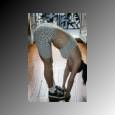 In
this stretch, your legs are straight (either together or spread
apart) and your back is bent over while you attempt to touch your
toes or the floor. If you do not have the ability to support much of
your weight with your hands when performing this exercise, your
knees are likely to hyperextend. This position can also place a
great deal of pressure on the vertebrae of the lower lumbar.
Furthermore, if you choose to have your legs spread apart, it places
more stress on the knees, which can sometimes result in permanent
deformity. In
this stretch, your legs are straight (either together or spread
apart) and your back is bent over while you attempt to touch your
toes or the floor. If you do not have the ability to support much of
your weight with your hands when performing this exercise, your
knees are likely to hyperextend. This position can also place a
great deal of pressure on the vertebrae of the lower lumbar.
Furthermore, if you choose to have your legs spread apart, it places
more stress on the knees, which can sometimes result in permanent
deformity.
-
- Leg Raises
-
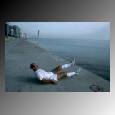 This
is any stretch where raise both feet a few inches off the ground.
This position squeezes (compresses) the spinal discs and pinches
nerve fibers in your back. This
is any stretch where raise both feet a few inches off the ground.
This position squeezes (compresses) the spinal discs and pinches
nerve fibers in your back.
Remember, without safety, there can be no
Jujitsu.
|
 In
this exercise, you lie down on your back and then try to sweep your
legs up and over, trying to touch your knees to your ears. This
position places excessive stress on the lower back, and on the discs
of the spine. Not to mention the fact that it compresses the lungs
and heart, and makes it very difficult to breathe. This particular
exercise also stretches a region that is frequently flexed as a
result of improper posture. This stretch is a prime example of an
exercise that is very easy to do incorrectly. However, with proper
instruction and attention to body position and alignment, this
stretch can be performed successfully with a minimal amount of risk
and can actually improve spinal health and mobility.
In
this exercise, you lie down on your back and then try to sweep your
legs up and over, trying to touch your knees to your ears. This
position places excessive stress on the lower back, and on the discs
of the spine. Not to mention the fact that it compresses the lungs
and heart, and makes it very difficult to breathe. This particular
exercise also stretches a region that is frequently flexed as a
result of improper posture. This stretch is a prime example of an
exercise that is very easy to do incorrectly. However, with proper
instruction and attention to body position and alignment, this
stretch can be performed successfully with a minimal amount of risk
and can actually improve spinal health and mobility.
 In
this exercise, your back is maximally arched with the soles of your
feet and the palms of your hands both flat on the floor, and your
neck tilted back. This position squeezes (compresses) the spinal
discs and pinches nerve fibers in your back.
In
this exercise, your back is maximally arched with the soles of your
feet and the palms of your hands both flat on the floor, and your
neck tilted back. This position squeezes (compresses) the spinal
discs and pinches nerve fibers in your back.
 In
this stretch, your legs are straight (either together or spread
apart) and your back is bent over while you attempt to touch your
toes or the floor. If you do not have the ability to support much of
your weight with your hands when performing this exercise, your
knees are likely to hyperextend. This position can also place a
great deal of pressure on the vertebrae of the lower lumbar.
Furthermore, if you choose to have your legs spread apart, it places
more stress on the knees, which can sometimes result in permanent
deformity.
In
this stretch, your legs are straight (either together or spread
apart) and your back is bent over while you attempt to touch your
toes or the floor. If you do not have the ability to support much of
your weight with your hands when performing this exercise, your
knees are likely to hyperextend. This position can also place a
great deal of pressure on the vertebrae of the lower lumbar.
Furthermore, if you choose to have your legs spread apart, it places
more stress on the knees, which can sometimes result in permanent
deformity.
 This
is any stretch where raise both feet a few inches off the ground.
This position squeezes (compresses) the spinal discs and pinches
nerve fibers in your back.
This
is any stretch where raise both feet a few inches off the ground.
This position squeezes (compresses) the spinal discs and pinches
nerve fibers in your back.